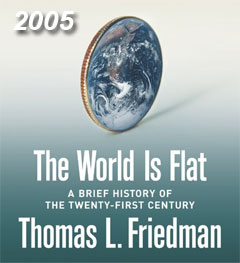|
Last week, SCDigest Editor Dan Gilmore gave his review of the decade in supply chain, focusing on key trends and changes throughout the 3000-2009 period.
As promised, below you will find a year-by-year chronology of the most important news and events of the decade – and quite a decade it was.
2000
Oil prices are in the $18-20 per barrel range for the year.
Feared technology disasters associated with year change to 2000 is avoided, as Jan. 1 comes mostly without any blips, in part resulting from massive IT spending in the prior few years to avoid the problem. However, “Y2K” related spending plus e-commerce mania set stage for tech bubble collapse the following year.
Imports from China into the US are $100 billion; by 2008, they are $338 billion.
In a huge company push, supply chain software provider i2 Technologies says it reaches $1 billion in sales for the year, in part from a series of frenzied deals near year end to reach that target. A subsequent accounting scandal and several restatements over the next few years later show actual sales in 2000 were much, much less.
Before anyone much cared, the Carbon Disclosure Project is launched in London, with a goal of pushing companies and their suppliers to report carbon emissions in a public and standard way. Group rises in prominence, especially in second half of the decade.
2001
Price of oil bottoms at just over $15.00 per barrel; from there, it begins a multi-year climb that dramatically impacts supply chain costs.
Internet bubble bursts, pounding technology stocks and dramatically reducing supply chain software adoption for two years.
China is admitted into the World Trade Organization, providing another catalyst for its export strategy and rapid rise in export levels.
Cisco writes off an astounding $2.1 billion in inventory as it fails to anticipate tech spending slow down. The debacle leads to important change in supply chain practice, as Wall Street analysts start paying a lot more attention to company inventory levels to find the next Cisco-like risk, and CEOs, CFOs and supply chain execs find the need to get inventory religion in response.
2002
 West coast terminal operators engage in a lockout of the Longshoremen’s union in an on-going labor dispute, paralyzing imports and exports for 10 days, causing some companies to increase use of non-West coast ports to reduce risk. West coast terminal operators engage in a lockout of the Longshoremen’s union in an on-going labor dispute, paralyzing imports and exports for 10 days, causing some companies to increase use of non-West coast ports to reduce risk.
Blue jeans icon Levi’s announces it is shuttering all its US production plants and moving production to Asia – a move many other manufacturers will emulate throughout the rest of the decade, deciding to become “brand, design, and distribution companies” – not producers.
Almost a decade in the making, the Alameda Corridor opens, providing a 10-mile long, underground rail system to move containers away from the ports of Los Angeles and Long Beach without needing over the road trucks.
Leading supply chain software provider McHugh Software changes its name to become RedPrairie.
Vinod Singhal of Georgia Tech and .Kevin Hendricks of The University of Western Ontario publish the first in a series of articles on how supply chain disruptions impact shareholder value. The research becomes a key driver of the growing focus on supply chain risk management in the rest of the decade.
2003
In June, Walmart announces plans for RFID tag mandate, later says it expects all vendor pallets and cases will be tagged within a few years.
EPCglobal organization formed in September as an arm of GS1, taking over from the work of MIT's Auto ID Center.
Yellow Freight announces plans to buy Roadway Express, its larger rival in the LTL shipping market. Additional acquisitions and down freight market lead to big financial troubles for the new YRC Worldwide later in decade.
In a bid to grab a big share of the US market, DHL announces it is buying Seattle-based Airborne Express for just over $1 billion, but planned synergies and market share growth never really materialize, while losses mount over rest of decade.
After a 15 year career in supply chain, Editor Dan Gilmore launches Supply Chain Digest in late 2003. His first column: “The sorry state of ASNs.”
ERP provider PeopleSoft announces it is buying rival JDEdwards.
The Federal Motor Carrier Safety Administration (FMCSA) changes regulations for commercial truck drivers related to hours of service (HOS), which modestly limits a driver’s availability to work in some areas(while actually increasing the number of hours they can drive in a day from 10 to 11). HOS rule change seems to dominate the transportation news and was generally opposed by carriers, but in retrospect the impact of the changes seems to have been almost unnoticeable.
2004
Quotas restricting textile and apparel imports from China are lifted, leading to a surge in sourcing from China in those categories over the next few years.
In December. Oracle announces it is buying PeopleSoft, which itself had acquired JDEdwards, as the ERP market consolidation continues and Oracle starts its multi-year buying spree. Earlier, PeopleSoft and the US Trade Commission had sought to block the deal, leading to documents showing there had been some light discussions between Microsoft and SAP about a merger.
Ports generally and LA/Long Beach specifically become overwhelmed with import volumes, leading to large delays in getting cargo ships into port and containers out of the terminals. “Santa’s not stuck in the chimney – he’s stuck in Long Beach” writes AMR analyst Greg Aimi over huge delays getting containers of goods for Christmas season in. In subsequent years, retailers and manufacturers start bringing in containers earlier, use additional ports, to mitigate the congestion. Problem largely gone by 2006.
Council of Logistics Management (CLM) announces in July that it is changing its name to Council of Supply Chain Management Professionals (CSCMP) effective Jan. 1, 2005. It’s a lot harder to say, for sure, but a sign of the mainstreaming of supply chain in business and probably an overdue move.
The Supply Chain Operations Reference Model (SCOR) is expanded to add a new process: Return.
The ocean shipping world starts to see the delivery and commissioning of a new generation of “mega-ships,” capable of holding 10,000 or more TEUs/containers. Some ports unable to handle these behemoths.
2005
Oil prices end the year in the $70 range, with predictions for “$100 per barrel” prices, as concerns about the cost of fuel rise to top of supply chain and even corporate radars. Fuel surcharges start to become big issue for shippers, with some claiming carriers making profit from the surcharges.
 Rick Blasgen, former supply chain and logistics executive at Kraft and ConAgra, is named president and CEO of the Council of Supply Chain Management Professionals in Chicago. Rick Blasgen, former supply chain and logistics executive at Kraft and ConAgra, is named president and CEO of the Council of Supply Chain Management Professionals in Chicago.
Germany’s Deutsche Post, after having acquired DHL earlier in the decade, now acquires British-based Exel Logistics, which also has a major US presence.
Walmart lets inventories get out of control, with inventory levels growing in 2005 at almost 90% of sales growth, after being over 90% in 2004, both far above company’s historical averages. Leads to InventoryDeLoad, ReMix and other programs that largely fix the problem within a couple of years.
Ocean shipping rates continue to climb, up 5-7% for the third straight year.
Trucking capacity is extremely tight; shippers pay bounties to get truckload carriers during peak fall shipping season.
New York Times columnist Thomas Friedman releases “The World is Flat,” both capturing and catalyzing globalization. Cites “Supply Chaining” as key enabler. Book is highly influential.
EPCglobal adopts so-call “Gen 2” EPC/RFID standard, which promises substantial improvements in EPC read performance.
(Supply Chain Trends and Issues Article - Continued Below)
|